Can you buy a man’s bike if you are a female triathlete?
 Karen Parnell
October 12, 2021
Karen Parnell
October 12, 2021
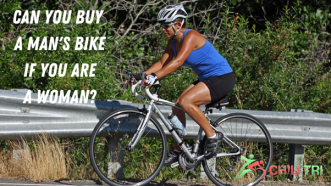
Why would a female triathlete buy a man’s bike?
As a coach I get asked this a lot when one of my female athletes who is just starting out gets offered a bike from a friend or see’s a great deal on a bike, but it happens to be a man’s bike.
In the past the differences were obvious. I collect bikes and the photo below shows my Raleigh Ebony that I bought to do an Eroica event that stated I needed to have a bike built up to 1987 with vintage features such as shift levers on the down tube. This was the same model I used to use to ride to work the first year of my engineering apprenticeship before it got stolen!
As you can see the top tube is angled downwards so a lady did not have to cock her leg to get on or even wear a skirt maybe?
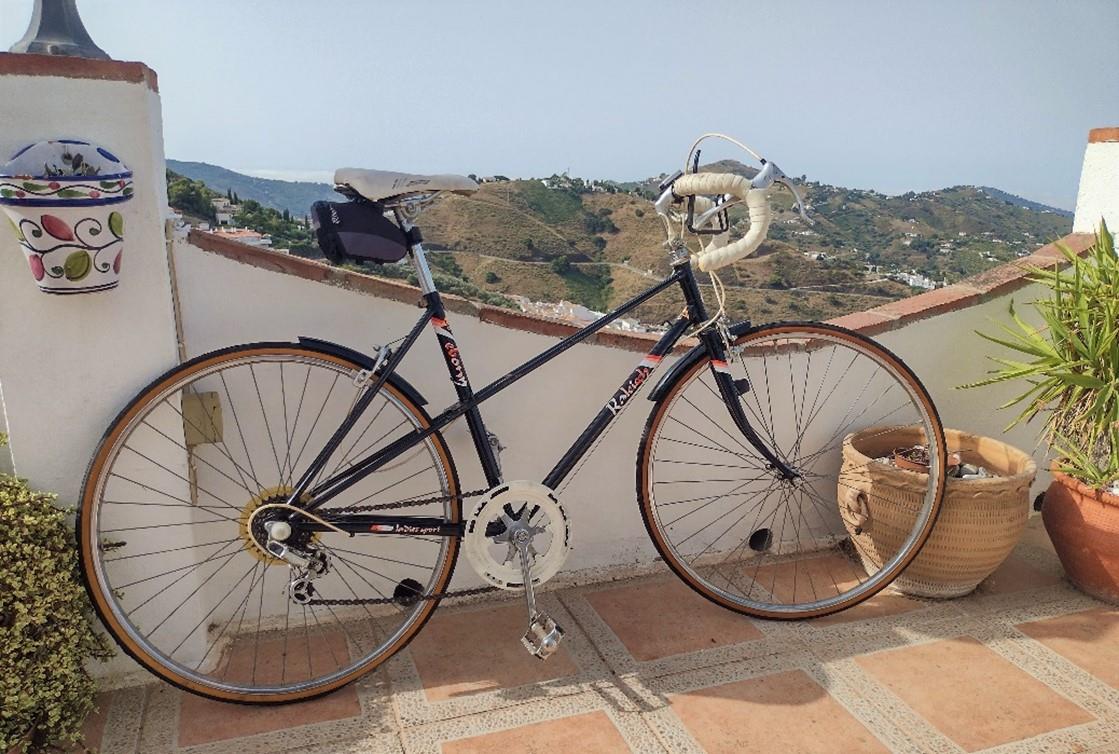
These days male and female bikes are remarkably similar with the same specification brakes, drive chain, shifters, frame material and wheels.
Get your FREE 31 Structured Cycling Sessions and Training Plan
The difference between women’s and men’s bikes
Bike makers have a lot of fit data that goes into frame geometry. Women, on average, are shorter than men, so women’s bike models generally have shorter stack heights. On average, women also have shorter torso lengths, so women’s bike models tend to have shorter reach lengths.
Plenty of women can often get a better ride on a man’s bike (aka unisex bike). A good bike shop will ignore marketing and concentrate on bikes that fit your body proportions. And the final word on fit isn’t what happens when you roll out of the store. It takes a few weeks of riding to assess things. After that, you should return to the bike shop to discuss what is and is not working. They can make adjustments, swap out components or, if need be, put you on a different-size model.
To learn some fundamentals about a bike fit this is a great video from GTN: https://www.youtube.com/watch?v=1iXAG9FYZq8
The major considerations for me are the points where my body touches the bike, and this may sound obvious, but many people just use the saddle, handlebars, pedals and crank arms that came with the bike. A good bike fitter will pay attention to these areas, and they are not just trying to sell you expensive parts but the ones that will make your cycling experience as comfortable and aerodynamic you can be within the bounds of your flexibility and body geometry. I won’t discuss pedals here but you can read about the latest types including magnetic ones here: https://www.tri247.com/triathlon-gear/bike-gear/chilitri-beginners-guide-bike-pedals
Get your FREE 31 structured indoor bike sessions for Zwift, Rouvy and TrainerRoad.
Other components that influence bike fit
The size or adjustments on key bike components also help it synch better with rider physiology: The stem, seat, handlebar, pedals and brake levers can all affect a bike’s overall fit and comfort.
The following components in women’s bikes also affect how well they fit:
Stem: This is the component most likely to get swapped out before you leave the store. A shorter or longer stem offers a simple way to fine-tune a bike frame’s reach for you. A different stem style might also put the handlebar at a higher position that’s more comfortable for riding. Handlebar geometry also comes into play, so bike shops will consider both stem and handlebar choice together during a fit assessment.
Seat: Generally, women’s saddles are shorter and wider. Women performance riders, though, often prefer narrow saddles that free up their pedalling motion. In addition, bike makers know that the saddle is one of the first components riders will change to match their preferences, so don’t get too hung up on the saddle if you like everything else about a bike.
Cut outs and relief channels were initially designed to meet men's needs. However, the industry noticed that women tended to prefer them so now the majority of women's saddles come with some sort of gap or groove. The ideal shape is very much down to personal preference.
Good bike shops will have loan saddles which you can borrow for a few weeks to try before you buy as sometimes it take a few long rides to see if it’s the one for you.
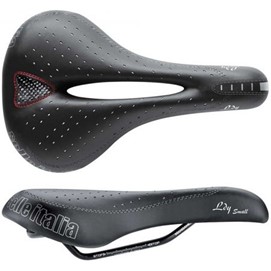
This is the saddle I use on long training rides the Selle Italia lady gel flow women's saddle which is a favourite for women cyclists
Get your FREE 31 structured indoor bike sessions for Zwift, Rouvy and TrainerRoad.
Handlebar: On average, women have narrower shoulders than men, so having narrower bars might suit you. Sore shoulders are one tipoff. If that’s happening after you get home, tell your bike shop when you go back in.
Brake levers: shorter riders often have smaller hands, making it hard to comfortably reach and operate brake levers. Some levers have adjustment screws that let you reduce lever reach; short-reach levers or junior levers are another option. On one of my bikes the fitter put shims into my brake lever cavity to decrease the initial reach but I’m not sure this is necessary anymore with a lot of levers having adjustment screws built in.
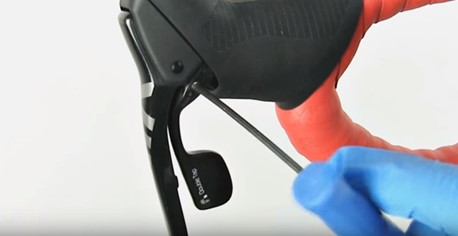
Adjusting the reach on brake levers
Get your FREE 31 Structured Cycling Sessions and Training Plan
Conclusion
A female triathlete can purchase and ride a man’s bike without a doubt and hopefully in the future there will just be road bikes and tri bikes of varying sizes to choose from to suit every shape and size. This does however assume that everyone will have a bike fit and be able to swap in women’s specific saddles for example. Some bike brands may transition to gender-neutral bikes (bikes for all). Instead of having, for example, four “men’s” sizes and four “women’s” sizes in a model, a bike model can come in five or six sizes. That offers a greater fit range for all riders, and smaller incremental changes between sizes provides a more precise fit for any single rider.
Right now, you will need to ask yourself why you want to buy a man’s bike? If it’s to save money then you may need to add in the cost of a women’s specific saddle, narrower handlebars, shorter handlebar stem and other adjustments you may need. You may also need to factor in the price of a good bike fit. I would always recommend a bike fit regardless to ensure you are comfortable for those long miles in the saddle. It’s always a good idea to return to your fitter after a couple of weeks to check the position and feedback any minor adjustments you will need to make.
So, depending on your physical size and geometry you could start from a men’s bike and adjust or from a women’s specific bike and get a bike fit from there. Either way a bike fit whether DIY or from your local bike shop is a must.
Get your FREE 31 structured indoor bike sessions for Zwift, Rouvy and TrainerRoad.
Karen Parnell is a Level 3 British Triathlon and IRONMAN Certified Coach, 8020 Endurance Certified Coach, WOWSA Level 3 open water swimming coach and NASM Personal Trainer and Sports Technology Writer.
Karen is currently studying for an MSc in Sports Performance Coaching at the University of Stirling.
Need a training plan? I have plans on TrainingPeaks and FinalSurge:
I also coach a very small number of athletes one to one for all triathlon and multi-sport distances, open water swimming events and running races, email me for details and availability. Karen.parnell@chilitri.com
Get your FREE Guide to Running Speed and Technique
Get your FREE Swim Workouts for Triathletes E-book
Get your FREE Open Water Swimming Sessions E-Book
Get your FREE 31 Structured Cycling Sessions and Training Plan
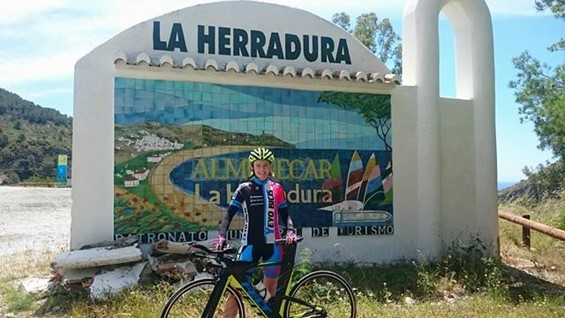
FAQ: Changing a men's road bike to be suitable for a female rider
Can a men's road bike be modified for a female rider?
Yes, a men's road bike can be modified to fit a female rider more comfortably and efficiently. With some adjustments, it's possible to create a better bike fit for women.
What changes need to be made to a men's road bike for a female rider?
Several modifications can be made to adapt a men's road bike for a female rider, including:
- Saddle: Swap the saddle for a women's-specific saddle that is designed to accommodate female anatomy and provide better comfort and support.
- Handlebars: Opt for narrower handlebars that better match the shoulder width of the female rider, providing improved control and a more natural hand position.
- Stem length and angle: Adjust the stem length and angle to achieve a more upright riding position and to accommodate the rider's reach and upper body proportions.
- Crank length: Consider switching to shorter crank arms to accommodate the generally shorter leg length of female riders and promote more efficient pedaling.
- Frame size: If the frame is too large, it may be necessary to downsize to a smaller frame size that better matches the rider's height and proportions.
Why is it important to modify a men's road bike for a female rider?
Modifying a men's road bike for a female rider is important to ensure a proper bike fit, which can enhance comfort, performance, and overall enjoyment of cycling. A well-fitted bike reduces the risk of discomfort, pain, and potential injuries, and allows for more efficient power transfer and control.
Should a female rider consider a women's-specific road bike instead?
While modifying a men's road bike can make it suitable for some female riders, it's worth considering a women's-specific road bike if possible. Women's-specific road bikes are designed with frame geometries and component specifications that are optimized for female riders, taking into account differences in body proportions and biomechanics. These bikes often provide a better fit and performance right out of the box.
Can a bike shop assist in modifying a men's road bike for a female rider?
Yes, a bike shop can be a valuable resource for modifying a men's road bike for a female rider. They can help assess the rider's needs, recommend appropriate component changes, and provide professional fitting services to ensure the bike is adjusted correctly.
Are there other considerations for female riders beyond bike modifications?
Yes, in addition to modifying the bike, female riders may want to consider other aspects for a more comfortable and enjoyable ride. These may include:
- Cycling apparel: Invest in well-fitted cycling apparel designed for women, including shorts with a women's-specific chamois and jerseys that accommodate the female physique.
- Bike fit assessment: Consider a professional bike fit assessment to ensure optimal positioning and comfort on the bike, taking into account individual body measurements and riding style.
- Training and conditioning: Engage in strength and flexibility exercises to support cycling performance and reduce the risk of injuries.
- Riding technique and skills: Seek guidance or attend cycling clinics to improve riding technique, efficiency, and overall enjoyment on the bike.
Remember, modifying a men's road bike for a female rider can greatly improve comfort and performance, but it's essential to consult with a bike shop or professional fitter to ensure the modifications are appropriate for your specific needs.
FAQ: Bike Fit
What is a bike fit?
A bike fit is the process of adjusting a bicycle to match the rider's unique body proportions, flexibility, and riding style. It involves making modifications to various components such as saddle position, handlebar reach, and pedal alignment to achieve an optimal and comfortable riding position.
Why is a bike fit important?
A bike fit is important for several reasons:
- Comfort: A proper bike fit helps reduce discomfort, pain, and fatigue during rides by ensuring that the bike is adjusted to match the rider's body mechanics and reduce unnecessary stress on joints and muscles.
- Injury prevention: An incorrect bike setup can lead to overuse injuries, such as knee pain, lower back pain, or numbness in the hands. A bike fit can help minimize the risk of these injuries by promoting better alignment and reducing strain on vulnerable areas.
- Performance enhancement: A bike fit optimizes power transfer, aerodynamics, and overall efficiency. It enables the rider to generate more power, maintain a more streamlined position, and ride with greater ease, leading to improved performance and potentially faster speeds.
- Handling and control: A well-fitted bike enhances stability, handling, and control, allowing the rider to manoeuvre with confidence and respond effectively to changing terrain or road conditions.
Who can benefit from a bike fit?
A bike fit is beneficial for riders of all levels and disciplines, including recreational cyclists, commuters, and competitive athletes. Whether you're a beginner or an experienced rider, a bike fit can improve your riding experience, reduce the risk of injuries, and optimize performance.
How is a bike fit performed?
A bike fit can be performed by a professional bike fitter or a knowledgeable bike shop staff member. The process typically involves the following steps:
- Interview and assessment: The fitter will gather information about your cycling goals, riding style, any existing discomfort or pain, and assess your flexibility and body measurements.
- Position adjustments: The fitter will make adjustments to key components such as saddle height, fore-aft position, handlebar reach, and angle to achieve an optimal riding position.
- Cleat alignment: If you use clip-in pedals, the fitter will align the cleats on your cycling shoes to optimize pedaling efficiency and reduce the risk of knee or foot issues.
- Fine-tuning: The fitter may make additional adjustments based on your feedback during a test ride on the bike trainer or a short ride outdoors. Fine-tuning may involve saddle tilt, handlebar height, or other minor changes.
How long does a bike fit session take?
The duration of a bike fit session can vary depending on the level of detail and the complexity of adjustments needed. On average, a bike fit session can last anywhere from one to three hours.
How often should I get a bike fit?
It's recommended to have a bike fit whenever you get a new bike, or if you experience discomfort or pain while riding. Additionally, as your fitness, flexibility, or riding goals evolve, it can be beneficial to reassess your bike fit to ensure it remains optimal for your needs.
Remember, a professional bike fit can provide personalized adjustments to maximize comfort, performance, and enjoyment on the bike. It's a valuable investment that can greatly enhance your cycling experience and help you reach your riding goals.
#buyingabike #femaletriathlete #femalecyclist #triathloncoach #triathlon #swimming #running #cycling #trainingcamps #trianingplans #chilitri #openwaterswimming #swimmingtrainingplan #cyclingtrainingplan #runningtrainingplan #swimming #cycling #running
